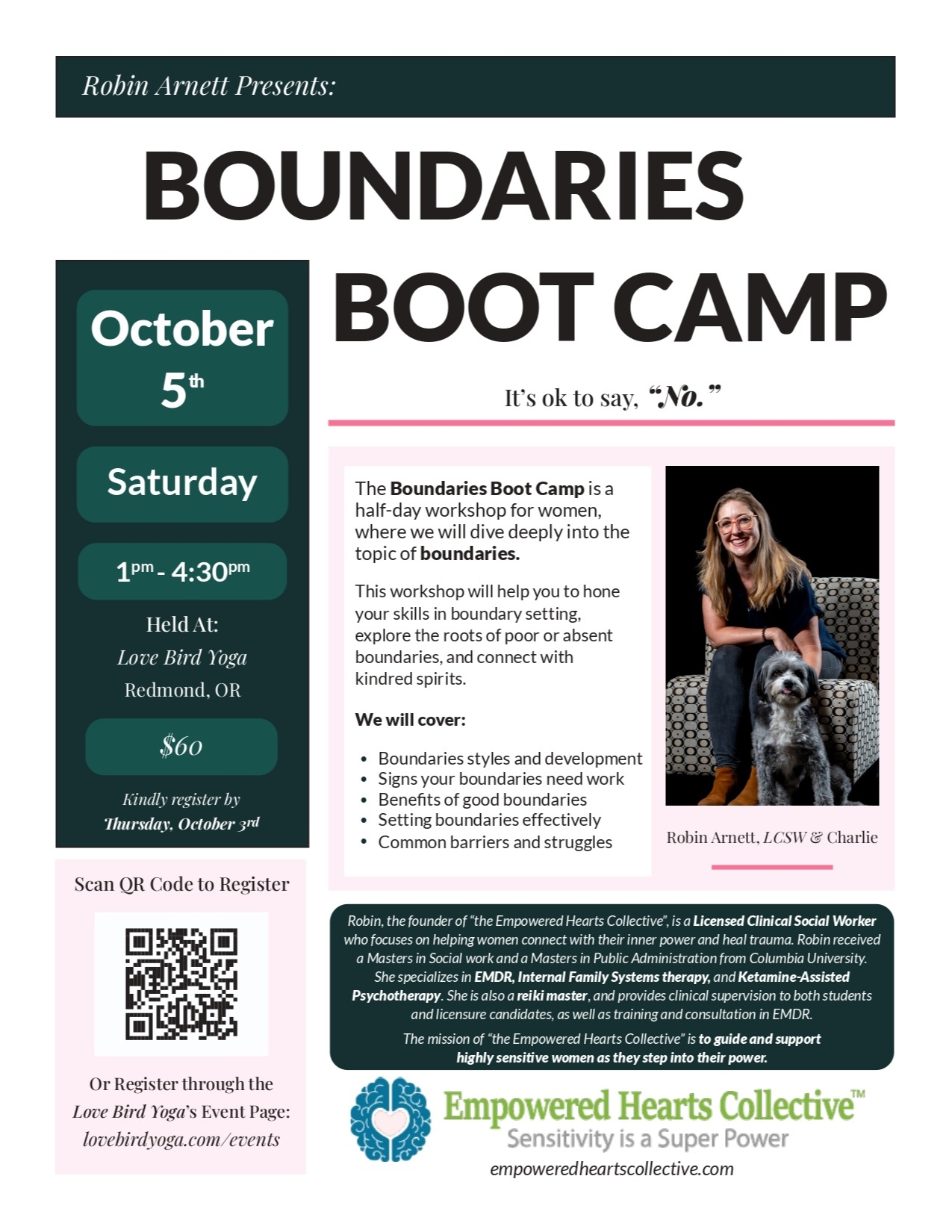Take the first step to stronger boundaries—unlock your free course, Module 7: Setting Effective Boundaries, from the Intuitive Boundaries Mastery Series.
Unlock Free ModuleGuest Blog: Using Polyvagal Theory to Listen To Your Body
By Julie Goldberg
This blog is written as a guest post by my friend and colleague, Julie Goldberg. Julie is the founder of Third Nature Therapy, a therapy group offering holistic mental health care for people seeking a different perspective on well-being. She offers Ketamine-Assisted Psychotherapy sessions in Brooklyn and somatic EMDR therapy sessions virtually. Her course on nervous system regulation aims to provide people with the skills needed to understand and befriend their own internal worlds.
As a trauma therapist with a private practice, a large part of my work with therapy clients is using polyvagal theory to help people map and track their autonomic nervous systems. Our biology is all mostly the same. We’re all wired to respond in similar ways. Our reactions are often NORMAL responses to ABNORMAL stressors.
Yet, our society is so far removed from ways to support our nervous system that when we respond with normal stress responses, usually coming from our bodies to our brains, we are made to believe that something is wrong with us instead of trusting the wisdom that is coming through our bodies.
We seek out medical attention and get prescribed anti-depressants more than any other country in the world. Often, these medications limit your ability to feel your bodily (or what I call somatic) responses as they come up. When we go on medication, we can mask the messages our body is sending. Ideally, we eventually tart to feel better and then decide to come off the medication.
But what I often see in my practice is that when people come off of their SSRI medications, their normal bodily responses arise once again.
This blog post will help you to stop that cycle. You’ll learn to trust the wisdom of your body and stop being scared by its messages. We need to get curious about what our bodies are trying to tell us.
To tap into these lessons, we’ll be using Polyvagal theory, which was discovered by Stephen Porges and taught to me by Deb Dana.
What is the Vagus Nerve?
Your vagus nerve controls your brain and body connection.
Quite literally, it controls everything you do. It runs from the back of your brain stem all the way down through the middle of your chest towards your belly. It’s the brain-gut connection.
Your vagus nerve controls the pace of your breathing, your heart rate, your digestive system, and your intestines. It also controls your ability to connect with the world and take in information.
Three Key Principles of Polyvagal Theory
1. Neuroception
The first key principle of Polyvagal theory is neuroception. Our bodies are wired to respond to cues of safety, danger, and threats from the world around us. These responses are completely out of our control, and our nervous systems are constantly looking for cues of safety, danger, and threats in our environment to keep us safe.
My nervous system is doing this right now as I write this blog post, and your nervous system is doing this as you read.
Before your brain consciously understands and assigns meaning to an experience, your autonomic nervous system is responding to the situation at hand. We are all constantly looking for signs of safety and connection in our environment. This is not something we can turn off.
We all respond differently to threats based on our history, but we’re responding regardless of what we think we can “control” or change.
2. Co-regulation
The second principle of polyvagal theory that's important to understand is co-regulation. Our nervous systems are designed to regulate together. This means that if I'm in a state of ease and presence, your nervous system will co-regulate and move towards mine when you are in close vicinity to me.
This also means that if I'm in a state of anxiety or stress, your nervous system will most likely move towards that as well.
Our nervous systems are designed to be in rhythm together. It's an evolutionarily beneficial trait, and it's kept us safe for many years. We are social creatures, and our nervous systems are designed to connect.
3. Hierarchy
The final principle of Polyvagal theory is that our nervous system moves in a hierarchical order from moment to moment every single day.
Our nervous system has three states, and we need all three states to function optimally.
The 3 Hierarchical States of Polyvagal Theory
Dorsal Vagal
The bottom state of our nervous system is Dorsal Vagal. You can think of this as a withdrawn, collapsed state of being. I like to think of it as lying on the couch, scrolling through my phone, looking on Instagram.
The Dorsal Vagal branch is located in your belly. Being in a dorsal vagal state is experienced as a sort of disconnection or collapse. It takes us out of connection with others and into a protective state.
In our modern environment, we don't have to be in an extreme state of danger to experience a dorsal response. Often, we experience this when we’re overwhelmed by our day. For me, as a therapist, if I schedule too many clients or too many meetings in one day, I feel a dorsal response at the end of the day. I collapse, retreat, withdraw, and experience extreme fatigue.
Pause and notice the events in your day-to-day life that create a sense of collapse and immobilization for you. If you’re having trouble coming up with ideas, just think about the times you move towards your phone and start to scroll.
Sympathetic
Following the Dorsal Vagal state is the Sympathetic state, which people commonly refer to as anxiety. It's the sense of activation and mobilization in our system.
Located in the middle of your spinal cord, you might notice that you feel anxiety in your chest— that’s because it’s connected to the sympathetic state.
The sympathetic stateIt’s the part of our body that prepares us for action. It’s the part that moves us from the collapse of turning inward into upright mobilization. This part of your nervous system is designed to respond to cues of danger. It releases adrenaline in your body, which activates you. It's your alarm system.
People often experience a sense of sympathetic activation throughout their workday. In modern times, we need a quick response time to do our jobs effectively, but we often get stuck in this response and perceive things as a threat when there is no threat or urgency.
Pause and notice what happensthings in your day-to-day life to create a sense of mobilization and fight or flight for you. If you’re having trouble coming up with anythignthings, just think of the energy that’s generated when you look at your “to-do” list.use yourof your “to-do list” energy.
Ventral Vagal
From sympathetic, you then move up into Ventral Vagal to access feelings of safety, connection, and ease. I like to think of ventral as a sigh.
This is the part of our nervous system that allows us to access safety and connection. It's the most recently developednewest part of our brainstem and the most evolved state of being. It allows us to enjoy our body and our home.It brings us into safety and connection, and it sends signals down to the heart and lungs that we are okay, you can slow down your breath, you can slow down your heart rate. It’s our ability to access a state of presence.
Pause and notice what the things in your day-to-day life that creates a sense of safety and connection. If you’re having trouble thinking of something coming up with things, think of the last time you smiled and really took a full breath.
Learning to listen and pay attention to the different states of your nervous system helps you navigate life’s challenges with more ease. If you are having a response to the world around you, listen to it.
Remember the three key principles of Polyvagal theory:
- Neuroception - How our autonomic nervous system takes in information
- Co-regulation - A physiological platform of safety that supports a feeling of security and connection
- Hierarchy - The autonomic nervous system responds to sensations in the body and signals from the environment through three pathways of response.
Your body is constantly giving you so much rich information.There is real wisdom and gifts to understanding how to pause and listen to these messages.


